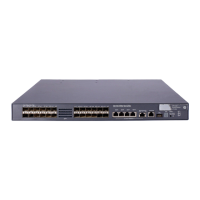113
Route Interface: not configured
Description: protocol VLAN for IPv4
Name: VLAN 0100
Tagged Ports:
GigabitEthernet1/0/3
Untagged Ports:
GigabitEthernet1/0/1
[DeviceA-GigabitEthernet1/0/3] display vlan 200
VLAN ID: 200
VLAN Type: static
Route Interface: not configured
Description: protocol VLAN for IPv6
Name: VLAN 0200
Tagged Ports:
GigabitEthernet1/0/3
Untagged Ports:
GigabitEthernet1/0/2
MAC-based VLAN configuration
Introduction to MAC-based VLAN
The MAC-based VLAN feature assigns hosts to a VLAN based on their MAC addresses. The following
approaches are available for configuring MAC-based VLANs:
Approach 1: Static MAC-based VLAN assignment
Static MAC-based VLAN assignment applies to networks containing a small number of VLAN users. In
such a network, you can create a MAC address-to-VLAN map containing multiple MAC address-to-VLAN
entries on a port, enable the MAC-based VLAN feature on the port, and assign the port to MAC-based
VLANs.
With static MAC-based VLAN assignment configured on a port, the switch processes received frames by
using the following guidelines:
• When the port receives an untagged frame, the switch looks up the MAC address-to-VLAN map
based on the source MAC address of the frame for a match. The switch first performs a fuzzy match.
In the fuzzy match, the switch searches the MAC address-to-VLAN entries whose masks are not all-Fs
and performs a logical AND operation on the source MAC address and each mask. If the result of
an AND operation matches the corresponding MAC address, the switch tags the frame with the
corresponding VLAN ID. If the fuzzy match fails, the switch performs an exact match. In the exact
match, the switch searches the MAC address-to-VLAN entries whose masks are all-Fs. If the MAC
address of a MAC address-to-VLAN entry matches the source MAC address of the untagged frame,
the switch tags the frame with the corresponding VLAN ID. If no match is found, the switch assigns a
VLAN to the frame by using the following criteria in turn: IP addresses, protocols, and ports.
• When the port receives a tagged frame, the port forwards the frame if the VLAN ID of the frame is
permitted by the port, or otherwise drops the frame.
Approach 2: Dynamic MAC-based VLAN assignment
When you cannot determine the target MAC-based VLANs of a port, you can use dynamic MAC-based
VLAN assignment on the port. To do that, you can create a MAC address-to-VLAN map containing

